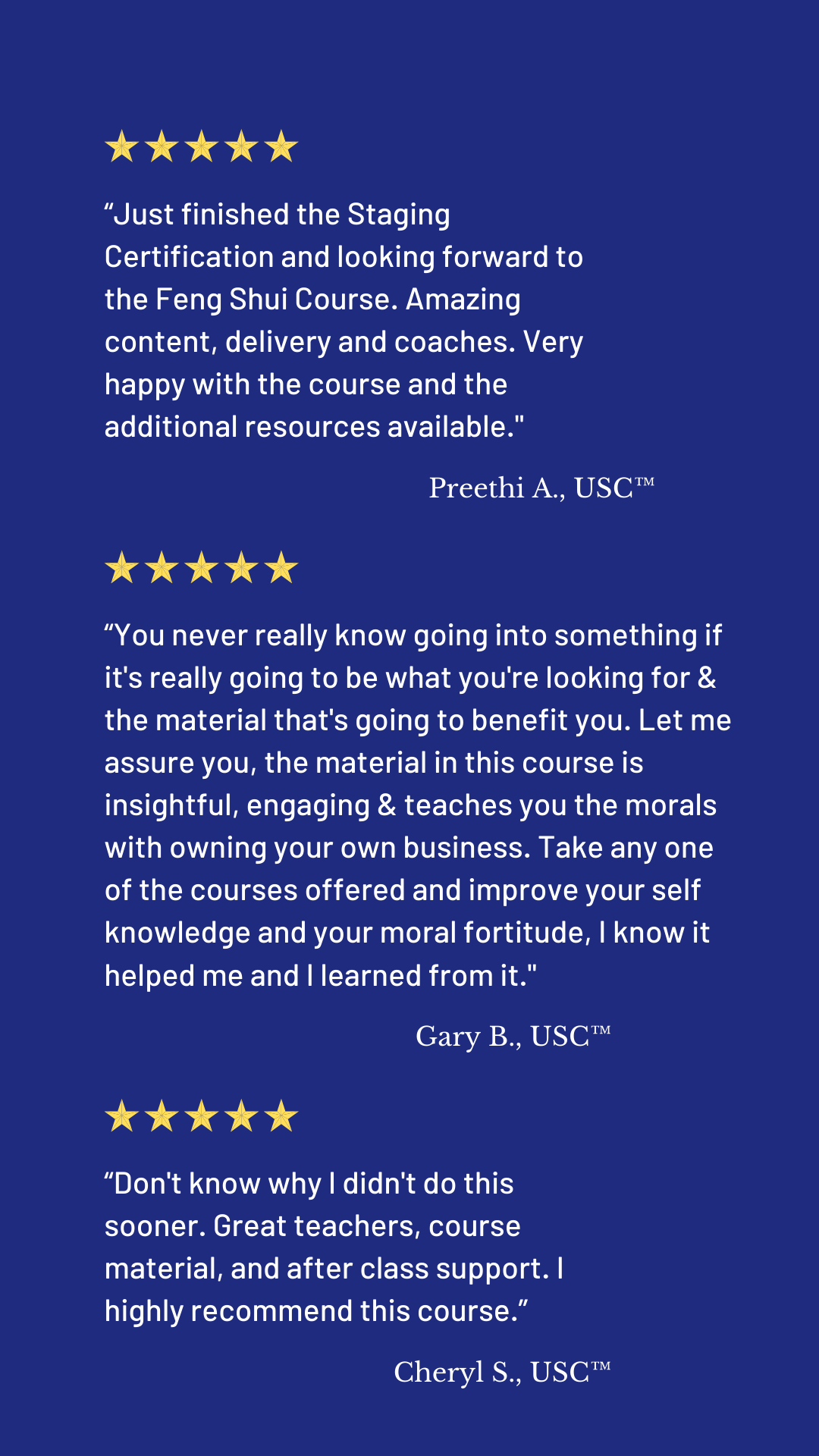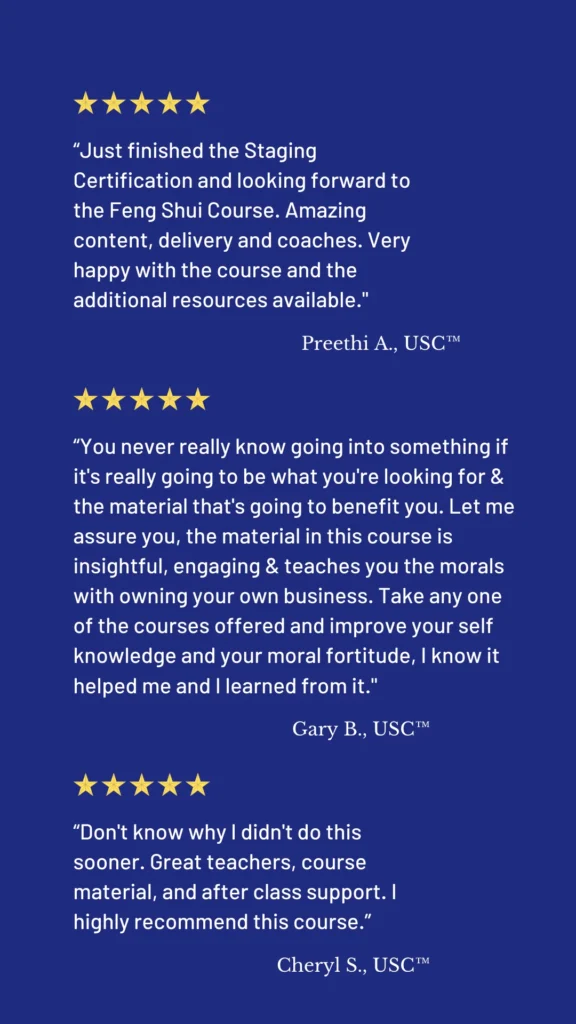Home Staging Challenges
and Their Solutions

As an UltimateStager™, you possess the knowledge and skills needed to expertly stage any home. You understand how to present spaces to appeal to a wide range of potential buyers, even tackling challenges like cluttered basements, small rooms, or unpleasant odors.
But what if the challenge isn’t just within the home? What if the challenge also lies with your client? Home staging professionals often work with various individuals, some of whom pose unique challenges. Knowing how to address these issues is crucial for your current and future success.
Solutions for Handling Personality Challenges:
Home stagers interact with a diverse group of homeowners and agents, and some may present more challenges than others. While no one can be categorized solely by their personality traits, certain characteristics may lead to specific challenges. Recognizing these challenges allows you to confront them effectively.
1. Dealing with a Challenging Client:
Some clients may be discouraging or pessimistic, even doubting the effectiveness of home staging.
Solution:
- Listen attentively to your client, providing them with an opportunity to express themselves, which can sometimes be all they need.
- Educate your clients by sharing relevant statistics and explaining your staging plan, emphasizing the reasons behind each step. Demonstrating your expertise can help dispel doubts about the staging process.
2. Handling an Emotional Client:
Moving homes can be emotional, especially if it involves leaving a cherished space.
Solution:
- Show empathy and understanding toward your clients, acknowledging that this is a sensitive time for them.
- Encourage open communication and address any concerns, strengthening your client’s trust in your professionalism.
- Confidently adapt to any situation, meeting your client’s needs effectively and showcasing your value as a professional home stager, extending beyond the staging itself.
3. Overly Opinionated Clients:
Solution:
- Active Listening: Pay close attention to your client’s opinions and concerns. Let them express themselves fully.
- Educate and Explain: Use your expertise to explain the rationale behind your staging choices. Provide facts and examples to support your decisions.
- Offer Alternatives: Be open to discussing alternative options that align with the client’s preferences while still achieving the goal of making the home appealing to a broad audience.
- Compromise: Seek common ground and find solutions that balance the client’s preferences with effective staging principles.
4. Indecisive Clients:
Solution:
- Provide Guidance: Offer guidance and recommendations to help clients make decisions. Share your expertise on what works best for staging.
- Create Mood Boards: Develop visual mood boards or examples of your proposed designs to make decision-making easier for clients.
- Set Deadlines: Establish clear timelines and decision deadlines to keep the project on track.
- Offer Support: Be patient and empathetic while clients deliberate, offering support and reassurance throughout the process.
5. Micro-Managing Clients:
Solution:
- Establish Boundaries: Clearly define your role and responsibilities in the staging process from the outset.
- Regular Updates: Keep clients informed of progress and updates, so they feel involved without needing to micromanage.
- Highlight Benefits: Emphasize how trusting your expertise and allowing you to manage the staging process can alleviate their stress and ensure a successful outcome.
- Respect Feedback: When clients provide feedback, acknowledge their concerns and discuss potential adjustments professionally.

General Home Staging Challenges
1. Oversized Furniture
Your client’s furniture may be too large for a space.
Solution:
- Ideally, have the homeowner remove the oversized furniture and rent appropriately sized pieces.
- If removal isn’t possible, consider removing a few chairs to improve room proportions and traffic flow. This may allow for better positioning of the remaining furniture.
2. Dated or Unattractive Furniture
Some clients may not have the budget or desire to replace dated or unattractive furniture.
Solution:
- Get creative by using slipcovers, neutral-colored throws, and pillows to hide or enhance existing furniture.
- In the bedroom, use luxurious bedding to improve the overall look.
- Add a warm, neutral-colored rug to divert attention from unflattering patterns.
- Rearrange furniture to create inviting conversation areas or highlight focal points.
These solutions can neutralize furniture while appealing to a wider range of potential buyers.
3. Altered Timelines
Homeowners may change project completion timelines.
Solution:
- Be flexible and understanding; homeowners have various commitments that may affect timelines.
- Use downtime productively, such as updating your inventory or setting up meetings with agents and potential clients.
- Emphasize the benefits of staying on schedule to homeowners, as a quicker sale benefits everyone involved.
4. Limited Natural Light
Solution:
- Enhance Lighting: Maximize artificial lighting with strategically placed lamps, light fixtures, and mirrors to create a well-lit and inviting atmosphere.
- Use Light Colours: Opt for light-coloured furniture, wall paint, and decor to reflect and amplify available light.
- Clean Windows: Ensure windows are clean and unobstructed to allow as much natural light as possible to enter the space.
- Trim or Replace Drapes: If heavy drapes or curtains block light, consider replacing them with sheer or lighter alternatives that let light through.
5. Small or Awkwardly Shaped Rooms
Solution:
- Furniture Arrangement: Select appropriately sized furniture and arrange it to maximize space and flow. Use multipurpose furniture, such as a sofa bed or nesting tables, to save space.
- Use Mirrors: Strategically place mirrors to create the illusion of larger space and reflect light.
- Minimalist Decor: Avoid overcrowding the room with excessive decor items. Keep it simple and focus on a few key pieces.
- Vertical Storage: Utilize vertical storage solutions like tall bookshelves or wall-mounted shelves to free up floor space.
6. Distracting or Personalized Decor
Solution:
- Depersonalize: Remove personal items like family photos, religious symbols, or highly personalized decor to allow potential buyers to envision the space as their own.
- Neutralize: Paint walls in neutral tones and opt for neutral decor items to create a blank canvas for buyers.
- Accessorize Thoughtfully: Add tasteful, non-personalized decor, such as artwork, vases, or throw pillows, to make the space inviting without overwhelming it.
- Consult with the Homeowner: Communicate with the homeowner about the need to depersonalize and neutralize the space, emphasizing the importance of appealing to a broader range of potential buyers.
Professionally staging a home requires skills and knowledge. There will be circumstances in which clients present you with home staging challenges.
By adapting to each situation and creating effective solutions, you can turn every challenge into an opportunity to flex your professional muscles.

Learn About our Home Staging Certification

FAQs About Home Staging Challenges
Avoiding: Sometimes, it’s best to avoid the conflict altogether if it’s trivial or if the timing for resolution is not appropriate.
Accommodating: This involves giving in to the other party’s demands or requests, often used when the issue matters more to the other party.
Competing: A win-lose approach where one party pursues their concerns at the other’s expense, useful in urgent or critical decisions.
Compromising: Each party gives up something, aiming for a quick, mutually acceptable solution that partially satisfies both.
Collaborating: A win-win situation where both parties work together to find a solution that fully satisfies both, ideal for resolving deep-rooted conflicts.
Effective ways to handle conflicts stemming from personality clashes or differences in temperament include:
- Emphasizing Open Communication: Encourage honest and respectful dialogue where each person can express their thoughts and feelings without fear of judgment.
- Focusing on Behaviour, Not Personality: Address specific behaviours that are causing issues rather than criticizing personal characteristics.
- Seeking Common Ground: Identify shared goals or interests to remind all parties of the bigger picture and the need to work together.
- Adopting Flexibility: Encourage flexibility and openness to different viewpoints and approaches to work.
- Providing Training: Offer conflict resolution and communication skills training to help individuals navigate personality differences more effectively.
- Utilizing Mediation: In cases where internal resolution is challenging, consider bringing in a neutral third party to facilitate understanding and compromise.
Handling client objections to staging recommendations involves a balance of empathy, expertise, and persuasive communication:
- Listen Actively: First, listen to the client’s concerns without interruption, showing that you value their input and understand their perspective.
- Acknowledge Their Concerns: Validate their feelings by acknowledging the concerns they have raised, demonstrating empathy and respect for their viewpoint.
- Educate and Inform: Use your expertise to explain the rationale behind your recommendations. Highlight how your suggestions are aligned with their goals, such as selling their home more quickly or for a higher price.
- Offer Alternatives: If resistance persists, be flexible by offering alternative solutions that may still meet the staging objectives while addressing the client’s concerns.
- Show Success Stories: Provide examples or case studies where similar staging recommendations have led to successful outcomes, helping to build trust in your expertise and vision.
- Seek Compromise: Work collaboratively with the client to find a compromise that respects both their preferences and the staging principles critical to achieving their end goal.
Pricing your home staging services effectively can be tricky, and it involves a careful balance of understanding the value you provide, the market demand, and competitive pricing strategies.
Here are steps to help you establish appropriate pricing for your services:
-
Assess Your Costs: Begin by calculating the costs involved in your services, including time, materials, furniture rentals, transportation, and any additional services you may offer. This will help ensure your pricing covers your expenses and leaves room for profit.
-
Understand Your Value: Consider the expertise, experience, and unique value propositions you bring to your clients. Higher expertise and unique services can command higher prices.
-
Research Market Rates: Look at what other home staging professionals in your area charge for similar services. This research will give you a ballpark figure for competitive pricing while allowing you to position your services appropriately within the market.
-
Consider Your Target Market: Your pricing should reflect the financial realities of your target market. Luxury properties may warrant higher staging fees compared to standard residential homes.
-
Offer Pricing Options: Consider offering different pricing tiers or packages to accommodate various needs and budgets. This approach can help attract a wider range of clients.
-
Pricing Matrix: Utilize tools and resources that can aid in pricing your services accurately. The Ultimate Academy®’s Home Staging course provides graduates with a pricing matrix to help them appropriately price their services. This matrix can serve as a valuable guide in determining prices that are fair, competitive, and profitable.
-
Adjust as Needed: Remember, your pricing isn’t set in stone. As you gain more experience, take on higher-value projects, or expand your services, revisiting and adjusting your pricing will be necessary to reflect your growing expertise and the changing market.
By following these steps and leveraging resources like the pricing matrix from the Ultimate Academy®’s Home Staging course, you can develop a pricing strategy that accurately reflects the value of your services, covers your costs, and ensures your business remains competitive and profitable.
Managing client expectations is crucial in home staging and begins with clear, open communication.
Home stagers explain to clients that the primary goal of staging is to make the home appeal to the widest possible audience, which often requires depersonalizing spaces and making decor changes that may not align with the homeowner’s personal taste.
Through expertise and experience, home stagers educate clients about the benefits of staging and the strategic choices made during the process.
Additionally, the Ultimate Academy®’s Home Staging course equips graduates with effective strategies for managing client expectations.
This education ensures that home stagers can confidently align staging strategies with the client’s ultimate goal of selling their property efficiently and at the best possible price, fostering an understanding of the staging process’s value and rationale.













